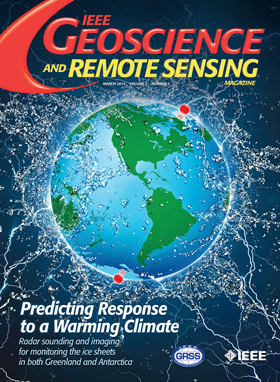Taking Artificial Intelligence Into Space Through Objective Selection of Hyperspectral Earth Observation Applications: To bring the “brain” close to the “eyes” of satellite missions
IF 16.2
1区 地球科学
Q1 GEOCHEMISTRY & GEOPHYSICS
引用次数: 2
Abstract
Recent advances in remote sensing hyperspectral imaging and artificial intelligence (AI) bring exciting opportunities to various fields of science and industry that can directly benefit from in-orbit data processing. Taking AI into space may accelerate the response to various events, as massively large raw hyperspectral images (HSIs) can be turned into useful information onboard a satellite; hence, the images’ transfer to the ground becomes much faster and offers enormous scalability of AI solutions to areas across the globe. However, there are numerous challenges related to hardware and energy constraints, resource frugality of (deep) machine learning models, availability of ground truth data, and building trust in AI-based solutions. Unbiased, objective, and interpretable selection of an AI application is of paramount importance for emerging missions, as it influences all aspects of satellite design and operation. In this article, we tackle this issue and introduce a quantifiable procedure for objectively assessing potential AI applications considered for onboard deployment. To prove the flexibility of the suggested technique, we utilize the approach to evaluate AI applications for two fundamentally different missions: the Copernicus Hyperspectral Imaging Mission for the Environment (CHIME) [European Union/European Space Agency (ESA)] and the 6U nanosatellite Intuition-1 (KP Labs). We believe that our standardized process may become an important tool for maximizing the outcome of Earth observation (EO) missions through selecting the most relevant onboard AI applications in terms of scientific and industrial outcomes.通过高光谱对地观测应用的客观选择将人工智能带入太空:让卫星任务的“大脑”靠近“眼睛”
遥感高光谱成像和人工智能(AI)的最新进展为科学和工业的各个领域带来了令人兴奋的机会,这些领域可以直接受益于在轨数据处理。将人工智能带入太空可能会加速对各种事件的反应,因为大规模的原始高光谱图像(HSI)可以在卫星上转化为有用的信息;因此,图像传输到地面的速度变得更快,并为全球各地的人工智能解决方案提供了巨大的可扩展性。然而,在硬件和能源限制、(深度)机器学习模型的资源节约、地面实况数据的可用性以及建立对基于人工智能的解决方案的信任方面,存在许多挑战。无偏、客观和可解释地选择人工智能应用程序对新兴任务至关重要,因为它影响卫星设计和运行的各个方面。在这篇文章中,我们解决了这个问题,并介绍了一个可量化的程序,用于客观评估机载部署的潜在人工智能应用。为了证明所建议技术的灵活性,我们利用该方法评估了两个根本不同任务的人工智能应用:哥白尼环境高光谱成像任务(CHIME)[欧盟/欧洲航天局(ESA)]和6U纳米卫星直觉-1(KP实验室)。我们相信,我们的标准化流程可能会成为一个重要工具,通过选择科学和工业成果方面最相关的机载人工智能应用程序,最大限度地提高地球观测(EO)任务的成果。
本文章由计算机程序翻译,如有差异,请以英文原文为准。
求助全文
约1分钟内获得全文
求助全文
来源期刊

IEEE Geoscience and Remote Sensing Magazine
Computer Science-General Computer Science
CiteScore
20.50
自引率
2.70%
发文量
58
期刊介绍:
The IEEE Geoscience and Remote Sensing Magazine (GRSM) serves as an informative platform, keeping readers abreast of activities within the IEEE GRS Society, its technical committees, and chapters. In addition to updating readers on society-related news, GRSM plays a crucial role in educating and informing its audience through various channels. These include:Technical Papers,International Remote Sensing Activities,Contributions on Education Activities,Industrial and University Profiles,Conference News,Book Reviews,Calendar of Important Events.
 求助内容:
求助内容: 应助结果提醒方式:
应助结果提醒方式:


